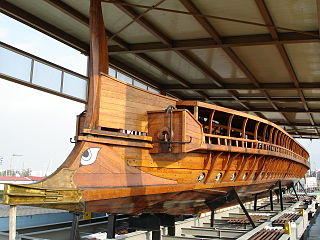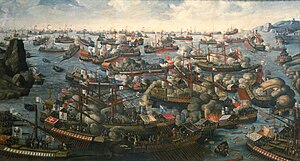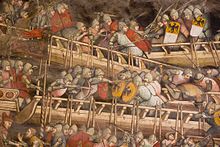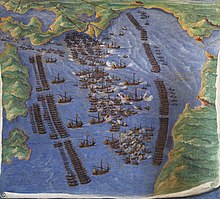
A trireme was an ancient vessel and a type of galley that was used by the ancient maritime civilizations of the Mediterranean Sea, especially the Phoenicians, ancient Greeks and Romans.

A warship or combatant ship is a ship that is built and primarily intended for naval warfare. Usually they belong to the armed forces of a nation. As well as being armed, warships are designed to withstand damage and are typically faster and more maneuverable than merchant ships. Unlike a merchant ship, which carries cargo, a warship typically carries only weapons, ammunition and supplies for its crew. Warships usually belong to a navy, though they have also been operated by individuals, cooperatives and corporations.

The Battle of the Lipari Islands or Battle of Lipara was a naval encounter fought in 260 BC during the First Punic War. A squadron of 20 Carthaginian ships commanded by Boödes surprised 17 Roman ships under the senior consul for the year Gnaeus Cornelius Scipio in Lipara Harbour. The inexperienced Romans made a poor showing, with all 17 of their ships captured, along with their commander.

The Battle of Cape Ecnomus or Eknomos was a naval battle, fought off southern Sicily, in 256 BC, between the fleets of Carthage and the Roman Republic, during the First Punic War. The Carthaginian fleet was commanded by Hanno and Hamilcar; the Roman fleet jointly by the consuls for the year, Marcus Atilius Regulus and Lucius Manlius Vulso Longus. It resulted in a clear victory for the Romans.
The naval Battle of Drepana took place in 249 BC during the First Punic War near Drepana in western Sicily, between a Carthaginian fleet under Adherbal and a Roman fleet commanded by Publius Claudius Pulcher.
The Battle of the Aegates was a naval battle fought on 10 March 241 BC between the fleets of Carthage and Rome during the First Punic War. It took place among the Aegates Islands, off the western coast of the island of Sicily. The Carthaginians were commanded by Hanno, and the Romans were under the overall authority of Gaius Lutatius Catulus, but Quintus Valerius Falto commanded during the battle. It was the final and deciding battle of the 23-year-long First Punic War.

From the 4th century BC on, new types of oared warships appeared in the Mediterranean Sea, superseding the trireme and transforming naval warfare. Ships became increasingly large and heavy, including some of the largest wooden ships hitherto constructed. These developments were spearheaded in the Hellenistic Near East, but also to a large extent shared by the naval powers of the Western Mediterranean, specifically Carthage and the Roman Republic. While the wealthy successor kingdoms in the East built huge warships ("polyremes"), Carthage and Rome, in the intense naval antagonism during the Punic Wars, relied mostly on medium-sized vessels. At the same time, smaller naval powers employed an array of small and fast craft, which were also used by the ubiquitous pirates. Following the establishment of complete Roman hegemony in the Mediterranean after the Battle of Actium, the nascent Roman Empire faced no major naval threats. In the 1st century AD, the larger warships were retained only as flagships and were gradually supplanted by the light liburnians until, by Late Antiquity, the knowledge of their construction had been lost.

A dromon was a type of galley and the most important warship of the Byzantine navy from the 5th to 12th centuries AD, when they were succeeded by Italian-style galleys. It was developed from the ancient liburnian, which was the mainstay of the Roman navy during the Empire.
The naval forces of the ancient Roman state were instrumental in the Roman conquest of the Mediterranean Basin, but it never enjoyed the prestige of the Roman legions. Throughout their history, the Romans remained a primarily land-based people and relied partially on their more nautically inclined subjects, such as the Greeks and the Egyptians, to build their ships. Because of that, the navy was never completely embraced by the Roman state, and deemed somewhat "un-Roman".

A galley was a type of ship which relied mostly on oars for propulsion that was used for warfare, trade, and piracy mostly in the seas surrounding Europe. It developed in the Mediterranean Sea region during antiquity and continued to exist in various forms until the early 19th century. It typically had a long, slender hull, shallow draft, and often a low freeboard. Most types of galleys also had sails that could be used in favorable winds, but they relied primarily on oars to move independently of winds and currents. The term "galley" originated from a Greek term for a small type of galley and came in use in English from about 1300. It has occasionally been used for unrelated vessels with similar military functions as galley but which were not Mediterranean in origin, such as medieval Scandinavian longships, 16th-century Acehnese ghalis and 18th-century North American gunboats.

The Byzantine navy was the naval force of the Byzantine Empire. Like the state it served, it was a direct continuation from its Roman predecessor, but played a far greater role in the defence and survival of the state than its earlier iteration. While the fleets of the Roman Empire faced few great naval threats, operating as a policing force vastly inferior in power and prestige to the army, command of the sea became vital to the very existence of the Byzantine state, which several historians have called a "maritime empire".

Panokseon (Korean: 판옥선) was a class of Korean oar- and sail-propelled ship that was the main class of warship used by Joseon during the late 16th century. The first ship of this class was constructed in 1555. These ships were built from sturdy pine wood and, as the primary warship of the Korean Navy, they were instrumental in victories under the command of Admiral Yi Sun-shin against numerically larger Japanese fleets during the 1592-1598 Japanese invasions of Korea.

Sailing ship tactics were the naval tactics employed by sailing ships in contrast to galley tactics employed by oared vessels. This article focuses on the period from c. 1500 to the mid-19th century, after which sailing warships were replaced with steam-powered ironclads.

A ram was a weapon fitted to varied types of ships, dating back to antiquity. The weapon comprised an underwater prolongation of the bow of the ship to form an armoured beak, usually between 2 and 4 meters (6–12 ft) in length. This would be driven into the hull of an enemy ship to puncture, sink or disable it.

Naval boarding action is an offensive tactic used in naval warfare to come up against an enemy marine vessel and attack by inserting combatants aboard that vessel. The goal of boarding is to invade and overrun the enemy personnel on board in order to capture, sabotage, or destroy the enemy vessel. While boarding attacks were originally carried out by ordinary sailors who are proficient in hand-to-hand combat, larger warships often deploy specially trained and equipped regular troops such as marines and special forces as boarders. Boarding and close quarters combat had been a primary means to conclude a naval battle since antiquity, until the early modern period when heavy naval guns gained tactical primacy at sea.

The Battle of Sena Gallica, was a naval battle fought off the Italian Adriatic coast in the autumn of 551 between an East Roman (Byzantine) and an Ostrogoth fleet, during the Gothic War (535–554). It marked the end of the Goths' brief bid to deny the seas to the Romans, and the beginning of the Byzantine resurgence in the war under the leadership of Narses.
Ancient navies had a large impact on the navies of today. The outcomes of battles between ancient navies have been studied by the military to learn tactics that would help in their conquests. The ships that these civilizations created were what many ship designs were based on and allowed the vessels to become better built. The Punic Wars are some of the most notorious wars in history, and the naval vessels and tactics used in all three became a major part of naval military history.

The navy of the Fatimid Caliphate was one of the most developed early Muslim navies and a major force in the central and eastern Mediterranean in the 10th–12th centuries. As with the dynasty it served, its history is in two phases. The first was c. 909 to 969, when the Fatimids were based in Ifriqiya ; the second lasted until the end of the dynasty in 1171, when they were based in Egypt. During the first period, the navy was employed mainly against the Byzantine Empire in Sicily and southern Italy, where it enjoyed mixed success. It was also in the initially unsuccessful attempts to conquer Egypt from the Abbasids and brief clashes with the Umayyad Caliphate of Córdoba.

The Venetian navy was the navy of the Venetian Republic which played an important role in the history of the republic and the Mediterranean world. It was the premier navy in the Mediterranean Sea for many centuries between the medieval and early modern periods, providing Venice with control and influence over trade and politics far in excess of the republic's size and population. It was one of the first navies to mount gunpowder weapons aboard ships, and through an organised system of naval dockyards, armouries and chandlers was able to continually keep ships at sea and rapidly replace losses. The Venetian Arsenal was one of the greatest concentrations of industrial capacity prior to the Industrial Revolution and responsible for the bulk of the republic's naval power.
Ancient Rome had a variety of ships that played crucial roles in its military, trade, and transportation activities. Rome was preceded in the use of the sea by other ancient, seafaring civilizations of the Mediterranean. The galley was a long, narrow, highly maneuverable ship powered by oarsmen, sometimes stacked in multiple levels such as biremes or triremes, and many of which also had sails. Initial efforts of the Romans to construct a war fleet were based on copies of Carthaginian warships. In the Punic wars in the mid-third century BCE, the Romans were at first outclassed by Carthage at sea, but by 256 BCE had drawn even and fought the wars to a stalemate. In 55 BCE Julius Caesar used warships and transport ships to invade Britain. Numerous types of transport ships were used to carry foodstuffs or other trade goods around the Mediterranean, many of which did double duty and were pressed into service as warships or troop transports in time of war.




















